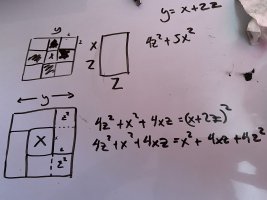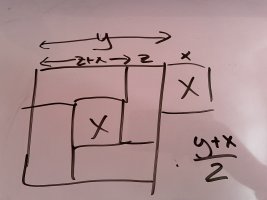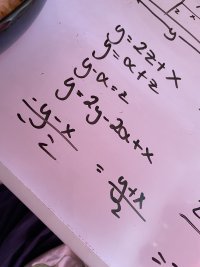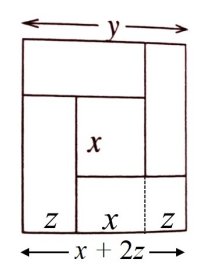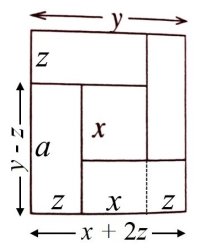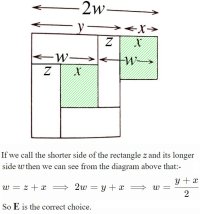You are using an out of date browser. It may not display this or other websites correctly.
You should upgrade or use an alternative browser.
You should upgrade or use an alternative browser.
Hint please
- Thread starter annaanna
- Start date
Dr.Peterson
Elite Member
- Joined
- Nov 12, 2017
- Messages
- 16,089
Don't think about areas at all.It is with great sadness that I kindly ask for a hint, I don’t know how to write z in terms of x or y View attachment 37542View attachment 37543
Just label every single segment in the picture (if necessary) in terms of x, y, and z, until you see some of them adding up to another. Then solve that equation for z.
Dr.Peterson
Elite Member
- Joined
- Nov 12, 2017
- Messages
- 16,089
You haven't shown your work. Write the equation first, then solve it:i should’ve just done this omg,, thinking outside the box View attachment 37544
z + x + z = y
Then z = what?
Then you can get x + z, and show why your answer is right.
Or did you do it a different way?
oh sorry I think my question was confusing I was ultimately trying to answer the question but I just needed to find a way to replace z with x or yYou haven't shown your work. Write the equation first, then solve it:
z + x + z = y
Then z = what?
Then you can get x + z, and show why your answer is right.
Or did you do it a different way?
The Highlander
Full Member
- Joined
- Feb 18, 2022
- Messages
- 937
You reached the right conclusion (eventually) but the method might be a bit clearer to any subsequent viewers if it's explained this way...well that would be (y-x)/2 but that isn’t the answer i think, i did it this way before thinking of the one above ( alpha is the length) View attachment 37545
First, to find the shorter side of the rectangle, we can redraw the diagram thus...
That gives us that:-
\(\displaystyle \qquad\enspace y = x + 2z\\\,\\\implies y - x = 2z\\\,\\\implies 2z = y - x\\\,\\\implies z=\frac{y-x}{2}\)
But we are asked to find the length of the rectangle's longer side so let's just call that a (rather than "alpha"
Now we can say that:-
\(\displaystyle \qquad\enspace a=y-z\\\,\\\implies a= y-\frac{y-x}{2}\\\,\\\implies 2a=2y-(y-x)\\,\\\implies 2a=2y-y+x\\\,\\\implies2a=y+x\\\,\\\implies a=\frac{y+x}{2}\)
And "E" is, therefore, the correct choice.
blamocur
Elite Member
- Joined
- Oct 30, 2021
- Messages
- 2,627
'z' is the shorter side of the rectangle, but now need to find the long one.well that would be (y-x)/2 but that isn’t the answer i think,
The Highlander
Full Member
- Joined
- Feb 18, 2022
- Messages
- 937
See above.'z' is the shorter side of the rectangle, but now need to find the long one.
did the outside the box thing come to mind when you saw it tho, do mathematicians pick up on that instantlyYou reached the right conclusion (eventually) but the method might be a bit clearer to any subsequent viewers if it's explained this way...
First, to find the shorter side of the rectangle, we can redraw the diagram thus...
That gives us that:-
\(\displaystyle \qquad\enspace y = x + 2z\\\,\\\implies y - x = 2z\\\,\\\implies 2z = y - x\\\,\\\implies z=\frac{y-x}{2}\)
But we are asked to find the length of the rectangle's longer side so let's just call that a (rather than "alpha"). then we can redraw the diagram thus...
Now we can say that:-
\(\displaystyle \qquad\enspace a=y-z\\\,\\\implies a= y-\frac{y-x}{2}\\\,\\\implies 2a=2y-(y-x)\\,\\\implies 2a=2y-y+x\\\,\\\implies2a=y+x\\\,\\\implies a=\frac{y+x}{2}\)
And "E" is, therefore, the correct choice.
The Highlander
Full Member
- Joined
- Feb 18, 2022
- Messages
- 937
Well, it seemed obvious to medid the outside the box thing come to mind when you saw it tho, do mathematicians pick up on that instantly
Dr.Peterson
Elite Member
- Joined
- Nov 12, 2017
- Messages
- 16,089
I'm not sure what you mean by "outside the box"; I'm not sure anyone has clearly stated the quick method you appear to have used (and discovered yourself?). I only see it now, looking back at your picture:did the outside the box thing come to mind when you saw it tho, do mathematicians pick up on that instantly
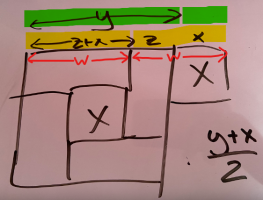
We see that y + x = 2w, so w = (y+x)/2.
Beautiful, and literally done by adding a box "outside the box".
What I'd assumed you did, seeing only the variables you explicitly used, was to solve for z first, and then get my w from that. That's what I did, and essentially what TH did (though his second part was considerably long than what I did (namely, just w = x+z = x+(y-x)/2=(y+x)/2).
How did you figure that out (or did you?)? The main point is that there are many ways to solve this, some faster than others, and we see whatever we happen to see, based on whatever experience we have, together with whatever perspective we happen to take at the start (in my case, seeing the variables you'd chosen, and wanting to discover what you might do). Elegant solutions are typically not the first ones we find, but come to us upon reflection (as this eventually did to me).
The Highlander
Full Member
- Joined
- Feb 18, 2022
- Messages
- 937
Sorry, I interpreted your "outside the box" to mean the expressions I had added outside the box at the bottom and the left-hand side.did the outside the box thing come to mind when you saw it tho, do mathematicians pick up on that instantly
If, as it would now appear, you were referring to the addition of the internal square to the top right-hand side of the diagram (as shown below), then it seems nobody else thought of that.
Well done!
I suspect that most people would approach it the same way that @Dr.Peterson and I did though, as he points out, your method is a good deal quicker (and much more elegant too).
(My "second part" was longer because I try to cater for those viewers who are only comfortable with 'baby steps' in the algebraic manipulation.
If I had realized what you were doing then I would have modified the diagram thus...
This is why these kind of problems are my favourite and I was 'sad' I had to ask for a hint with it, unfortunately I didn't discover the method it was more like the answer discovered it for me, (I was annoyed that it took me so long to find the answer then was like 'what on earth does (y-x)/2 even meanI'm not sure what you mean by "outside the box"; I'm not sure anyone has clearly stated the quick method you appear to have used (and discovered yourself?). I only see it now, looking back at your picture:
View attachment 37551
We see that y + x = 2w, so w = (y+x)/2.
Beautiful, and literally done by adding a box "outside the box".
What I'd assumed you did, seeing only the variables you explicitly used, was to solve for z first, and then get my w from that. That's what I did, and essentially what TH did (though his second part was considerably long than what I did (namely, just w = x+z = x+(y-x)/2=(y+x)/2).
How did you figure that out (or did you?)? The main point is that there are many ways to solve this, some faster than others, and we see whatever we happen to see, based on whatever experience we have, together with whatever perspective we happen to take at the start (in my case, seeing the variables you'd chosen, and wanting to discover what you might do). Elegant solutions are typically not the first ones we find, but come to us upon reflection (as this eventually did to me).
Last edited:
oh I thought it was so cool when you said it was obvious to you that I was very excited to become better at maths hahaSorry, I interpreted your "outside the box" to mean the expressions I had added outside the box at the bottom and the left-hand side.
If, as it would now appear, you were referring to the addition of the internal square to the top right-hand side of the diagram (as shown below), then it seems nobody else thought of that.
Well done!
I suspect that most people would approach it the same way that @Dr.Peterson and I did though, as he points out, your method is a good deal quicker (and much more elegant too).
(My "second part" was longer because I try to cater for those viewers who are only comfortable with 'baby steps' in the algebraic manipulation.)
If I had realized what you were doing then I would have modified the diagram thus...
What a brilliant mind you have Dr.Peterson!I'm not sure what you mean by "outside the box"; I'm not sure anyone has clearly stated the quick method you appear to have used (and discovered yourself?). I only see it now, looking back at your picture:
View attachment 37551
We see that y + x = 2w, so w = (y+x)/2.
Beautiful, and literally done by adding a box "outside the box".
What I'd assumed you did, seeing only the variables you explicitly used, was to solve for z first, and then get my w from that. That's what I did, and essentially what TH did (though his second part was considerably long than what I did (namely, just w = x+z = x+(y-x)/2=(y+x)/2).
How did you figure that out (or did you?)? The main point is that there are many ways to solve this, some faster than others, and we see whatever we happen to see, based on whatever experience we have, together with whatever perspective we happen to take at the start (in my case, seeing the variables you'd chosen, and wanting to discover what you might do). Elegant solutions are typically not the first ones we find, but come to us upon reflection (as this eventually did to me).
Dr.Peterson
Elite Member
- Joined
- Nov 12, 2017
- Messages
- 16,089
Your trick amounts to what I think of as concrete algebra or visual algebra. In a sense, you added x to both sides of an equation to make it easier to solve. I greatly enjoy finding non-algebraic methods for solving problems, because algebra is routine, while this sort of solving is creative.This is why these kind of problems are my favourite and I was 'sad' I had to ask for a hint with it, unfortunately I didn't discover the method it was more like the answer discovered it for me, (I was annoyed that it took me so long to find the answer then was like 'what on earth does (y-x)/2 even meanso then I thought about it and realised it's basically the image above with it being outside the box) What is this stuff called? basic algebra in geometry? I want to get a degree in it.
The method we saw first is the routine way: just label the different quantities, write equations to relate them, and solve. And your assignment of variables led directly to it. If I were solving the problem on my own, I might have added only w, since that is the goal; but since it feels less natural, I might just have used z as you did. Using w, the work would be:
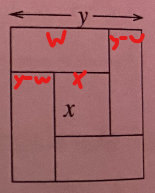
w = (y-w)+x, so 2w = y+x and w = (y+x)/2
Alternatively, I might just see that the widths on either side of x are equal, so they are both equal to (y-x)/2, and therefore w = (y-x)/2 + x = (y-x + 2x)/2 = (y+x)/2:
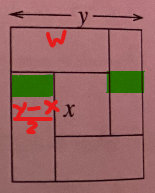
In any case, the basic strategy with algebra is to label parts of the diagram with either new variables, or expressions in the existing ones, until you have an equation expressing two ways to get the same quantity.


